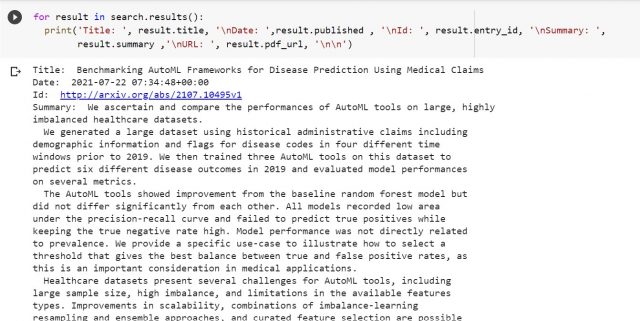
In this post, you will learn about Python source code related to search Arxiv for relevant and latest machine learning and data science research papers. If you are looking for a faster way to research on Arxiv papers without really going to the Arxiv website, you may want to get this piece of code in your kitty. You can further automate the Arxiv search to get notified based on some logic. Without further ado, let’s get started.
Step 1: Install Python Arxiv Library
As a first step, install the Python Arxiv library using the code such as below in your Jupyter notebook or Google colab instance:
pip install arxiv
Step 2: Execute the code to search the papers
Once the Arxiv library is set up, the next step is to execute the code to retrieve the papers based on keywords search. Here is the code.
import arxiv
search = arxiv.Search(
query = "automl",
max_results = 3,
sort_by = arxiv.SortCriterion.SubmittedDate,
sort_order = arxiv.SortOrder.Descending
)
Pay attention to some of the following in the above Python code:
- Parameter “query” is used to assign the query word (text format).
- Parameter “max_results” is used to assign the number of results (numeric). If not set, the default value is 10 and the maximum limit is 300,000 results.
- Parameter “sort_by” is used to specify the criteria that would be used to sort the output. The value can submittedDate, lastUpdatedDate, relevance. When set to submittedDate, you can search for latest papers.
- Parameter “sort_order” is used to specify the order in which results will be sorted. The value can be Ascending or Descending.
- There is also an additional parameter called as id_list which can be used in place of query when one wants to get specific set of papers. You can specify the id_list with ids array. It can be in the format such as id_list = [“2107.10495v1”].
You can use some of the following query formats to search specific and focused papers when you have multiple keywords:
- Use double quotes such as query = “\”logistic regression\””
- Use AND and OR operator. For example, searching application of random forest in insurance domain such as query = “insurance AND \”random forest\””
Step 3: Print the search results
Finally, you can print the result using commands such as the following.
for result in search.results():
print('Title: ', result.title, '\nDate: ',result.published , '\nId: ', result.entry_id, '\nSummary: ',result.summary ,'\nURL: ', result.pdf_url, '\n\n')
This will show the output such as the following:

You can print some of the following using different attributes of the result object:
- result.entry_id
- result.published
- result.title
- result.summary
- result.authors
- result.pdf_url
- result.primary_category
- result.categories
- result.links
Putting the code together
Here is the quick Python code you could copy and get started right away. The code below searches for papers consisting of keywords healthcare and machine learning.
import arxiv
search = arxiv.Search(
query = "healthcare AND \"machine learning\"",
max_results = 3,
sort_by = arxiv.SortCriterion.SubmittedDate,
sort_order = arxiv.SortOrder.Descending
)
for result in search.results():
print('Title: ', result.title, '\nDate: ',result.published , '\nId: ', result.entry_id, '\nSummary: ',
result.summary ,'\nURL: ', result.pdf_url, '\n\n')
- Coefficient of Variation in Regression Modelling: Example - November 9, 2025
- Chunking Strategies for RAG with Examples - November 2, 2025
- RAG Pipeline: 6 Steps for Creating Naive RAG App - November 1, 2025
I found it very helpful. However the differences are not too understandable for me